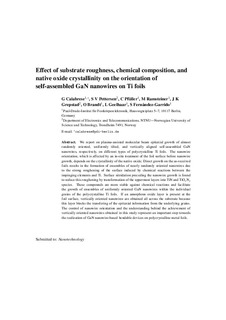| dc.contributor.author | Calabrese, G | |
| dc.contributor.author | Pettersen, Sverre Vegard | |
| dc.contributor.author | Pfuller, C | |
| dc.contributor.author | Ramsteiner, M | |
| dc.contributor.author | Grepstad, Jostein | |
| dc.contributor.author | Brandt, O | |
| dc.contributor.author | Geelhaar, L | |
| dc.contributor.author | Fernandez-Garrido, S | |
| dc.date.accessioned | 2018-04-30T07:39:30Z | |
| dc.date.available | 2018-04-30T07:39:30Z | |
| dc.date.created | 2018-01-09T13:58:59Z | |
| dc.date.issued | 2017 | |
| dc.identifier.issn | 0957-4484 | |
| dc.identifier.uri | http://hdl.handle.net/11250/2496462 | |
| dc.description.abstract | We report on plasma-assisted molecular beam epitaxial growth of almost randomly oriented, uniformly tilted, and vertically aligned self-assembled GaN nanowires (NWs), respectively, on different types of polycrystalline Ti foils. The NW orientation with respect to the substrate normal, which is affected by an in situ treatment of the foil surface before NW growth, depends on the crystallinity of the native oxide. Direct growth on the as-received foils results in the formation of ensembles of nearly randomly oriented NWs due to the strong roughening of the surface induced by chemical reactions between the impinging elements and Ti. Surface nitridation preceding the NW growth is found to reduce this roughening by transformation of the uppermost layers into TiN and TiO x N y species. These compounds are more stable against chemical reactions and facilitate the growth of uniformly oriented GaN NW ensembles on the surface of the individual grains of the polycrystalline Ti foils. If an amorphous oxide layer is present at the foil surface, vertically oriented NWs are obtained all across the substrate because this layer blocks the transfering of the epitaxial information from the underlying grains. The control of NW orientation and the understanding behind the achievement of vertically oriented NWs obtained in this study represent an important step towards the realization of GaN NW-based bendable devices on polycrystalline metal foils. | nb_NO |
| dc.language.iso | eng | nb_NO |
| dc.publisher | IOP Publishing | nb_NO |
| dc.title | Effect of surface roughness, chemical composition, and native oxide crystallinity on the orientation of self-assembled GaN nanowires on Ti foils | nb_NO |
| dc.type | Journal article | nb_NO |
| dc.type | Peer reviewed | nb_NO |
| dc.description.version | acceptedVersion | nb_NO |
| dc.source.volume | 28 | nb_NO |
| dc.source.journal | Nanotechnology | nb_NO |
| dc.source.issue | 42 | nb_NO |
| dc.identifier.doi | 10.1088/1361-6528/aa84a1 | |
| dc.identifier.cristin | 1538876 | |
| dc.description.localcode | Locked until 20.9.2018 due to copyright restrictions. This is an author-created, un-copyedited version of an article accepted for publication/published in [Nanotechnology]. IOP Publishing Ltd is not responsible for any errors or omissions in this version of the manuscript or any version derived from it. The Version of Record is available online at http://iopscience.iop.org/article/10.1088/1361-6528/aa84a1/meta | nb_NO |
| cristin.unitcode | 194,63,35,0 | |
| cristin.unitname | Institutt for elektroniske systemer | |
| cristin.ispublished | true | |
| cristin.fulltext | original | |
| cristin.qualitycode | 2 | |
